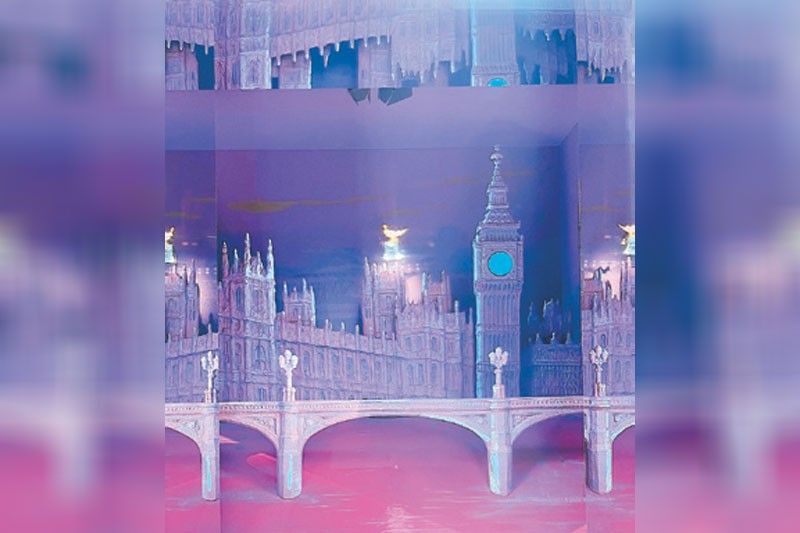Artists conjure new dreams for Tiffany

LONDON – The most spectacular windows during our visit would have to be the ones at Selfridges, thanks to Tiffany and Co. taking over the store’s outdoor displays that made a virtual art gallery of its storefront featuring works by notable British artists alongside those inspired by the jewelry company’s archives, many of which brought back memories of our favorites in New York and other cities through the years
It was a fitting homage to Tiffany’s nearly 200-year history and the famous windows at its flagship Fifth Avenue store in New York where the stunning displays have always been a signature draw and a proud tradition, epitomized by the enduring film, Breakfast at Tiffany’s, where Audrey Hepburn, playing Holly Golightly, was always drawn to the store’s windows, immortalizing the iconic scene of admiring the displays while eating a croissant.
The scene would also embody the spirit of the store’s founder, Charles Lewis Tiffany, who always understood the universal desire to dream about something bigger than oneself, and this lived on through the magical windows that never fail to surprise, inspire and create desire.

When Gene Moore joined the company in 1955, he revolutionized the look of window displays through his pioneering designs that were radical and witty, juxtaposing Tiffany jewelry with unexpected, quotidian materials like string, popcorn and even a toy dump truck. From a pile of dirt, a bird would tug at a “worm” that turned out to be a dazzling diamond necklace.
He invited kindred minds to collaborate with him – celebrated artists including Andy Warhol, Robert Rauschenberg and Jasper Johns. The Tiffany storefront became a democratic gallery for all who passed by through the decades, a longstanding connection to the arts that the company chose to honor for the Selfridges takeover.
There was Damien Hirst, the enfant terrible of British art, known for his bold style and provocative works that explore the complex relationships between life, death, beauty and religion. True to form, he gave the windows a jolt with a giant cough syrup bottle and a supersized 300 mg. capsule in keeping with his “Pharmacy” body of work, all in the signature Tiffany Blue 1837, of course. His recurring theme of butterflies evokes themes of hope and metamorphosis to balance Tiffany’s storied past with its constant embrace of innovation which is also reflected in Elsa Peretti’s free-form jewelry, which the artist chose to have a dialogue with his medical sculptures.
Rana Begum also chose Peretti as a touchpoint. Harmoniously blending sculpture, painting and architecture inspired by both urban landscapes and Islamic art, she created a geometric, reflective composition that explores the connection between her art and the craft of jewelry making. Fascinated by how Peretti’s Bone Cuff follows the contours of the body, Begum considered the interaction of her artwork with the body, movement and light. Absorbing and reflecting varying intensities of light, her work creates profound sensory experiences, a refined playfulness that mirrors Tiffany’s penchant for balancing elegant design and artistic innovation with a hint of wit.

James Righton, a musician and creative force whose electrifying performances blur the lines between art and music, employs light through a complex system of illuminated circles and motors, combining the visual and the aural through undulating shapes that respond to his hypnotic, ever-changing piece which evokes the human heartbeat. He took a cue from his observation that “our experiences, from the natural world to human existence, repeat but are never the same,” thereby creating music that’s a play between interwoven ostinatos, hoping that by the end of the piece, the listener would feel like he has been on a journey.
Within this immersive interplay of light and sound, the HardWear by Tiffany collection seamlessly takes center stage, with each link finished by hand – a delicate balance of
presence and proportion. This elegant collection is also at the heart of Jason Bruges’ installation which uses cutting-edge mathematics and algorithms to explore how generative beams of light interact with the internal volume of a diamond, creating a dazzling, kaleidoscopic effect. The renowned Tiffany Diamond is employed to produce a set of internal reflections within a geometric 3D model, resulting in a dancing, luminous collection. The artist frequently addresses themes of nature and connectedness, human impact on the environment and the complexities of life through various media meticulously designed to engage viewers, spark conversation and inspire thought.

In paying homage to its archives, many of the windows feature themes from nature which was always a rich source for designer Jean Schlumberger who dreamt up an aquatic world of jewelry that was reimagined for the Blue Book 2023 collection by Nathalie Verdeille. The pieces are right at home in Mariko Kusumoto’s tableau with fantastical sculptures that seem to float, referencing the hypnotic movement of the sea while the intricate construction and enticing marine-like shapes recall the design motifs found in the collection’s jewels.
Going back to terra firma, a window inspired by the classic Tiffany Studio Butterfly Table Lamp, glows with a blown-up top view of the circular lamp shade’s stained glass pattern, punctuated by jewelry from the Titan collection designed by Pharrell Williams. The celebrated lamp was designed in 1898 by Clara Driscoll, one of the women that Louis
Comfort Tiffany employed for design roles, defying common practice at that time. The choice of Williams, a multi-hyphenate who is not a traditional jewelry designer is also an unorthodox one. Both the Butterfly lamp and the Titan jewelry collection are lively symbols of Tiffany’s enduring commitment to inclusivity and diversity while pushing artistic and aesthetic boundaries.
* * *
Follow the authors on Instagram @rickytchitov; X @RickyToledo23; Facebook - Ricky Toledo Chito Vijandre



















